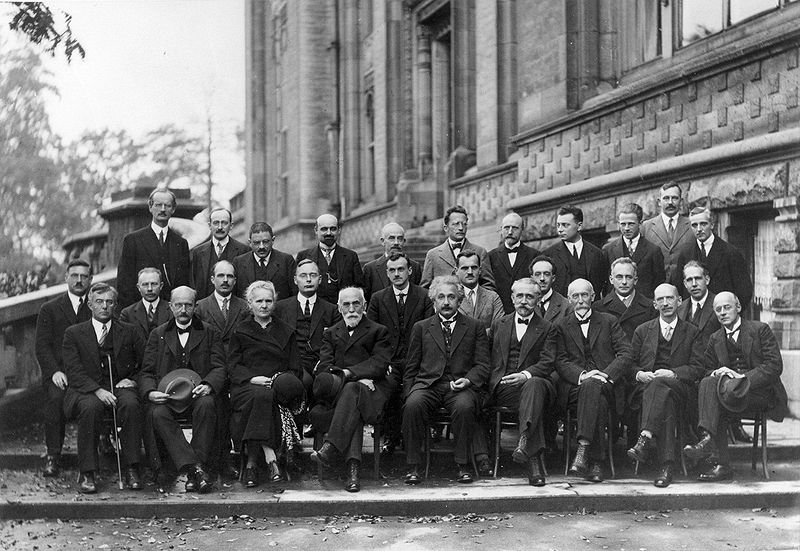EARTH, Milky Way -- They say crazy is as crazy does and few kinds of crazy do as much craziness as the kind embodied by particle physicists. I said it. They're crazy. The lot of 'em. I'm bound and determined to get belief in the standard model of particle physics included in psychiatric manuals as prima facie evidence of a heretofore undescribed variant of schizophrenia I'm calling, for the time being, Quarkomania.
One of the original examples of maniacal thinking in the quantum physics world concerned uncertainty and a cat, the pet tabby perhaps of one Erwin Schrödinger. In 1935 Schrödinger posed this thought experiment: Suppose you put a cat in a sealed box wherein his life or death depends upon the state of a subatomic particle. Yeah, that's already kind of whackadoodly, but play along. I'll use Schrödinger's own words because mine couldn't do justice to the hypothesis.
In a Geiger counter, there is a tiny bit of radioactive substance, so small that perhaps in the course of the hour, one of the atoms decays, but also, with equal probability, perhaps none; if it happens, the counter tube discharges, and through a relay releases a hammer that shatters a small flask of hydrocyanic acid. If one has left this entire system to itself for an hour, one would say that the cat still lives if meanwhile no atom has decayed.
But of course if an atom has decayed, then in the box is a dead cat. From the doubt inherent in such a case Schrödinger concludes through a shrewd bit of reduction to absurdity that for an hour, as long as the box remains sealed, one is forced to conclude that as far as we know the cat is both alive and dead at the same time and with apologies to the living Schrödingers, y'all are descended from a wingnut.
I can tell if the cat's alive or dead without looking because a live cat sealed up in a box will scratch and hiss like Lindsay Lohan at a pharmacy. Quiet box = dead cat. Duh.
But then that's too simple for particle physicists. I'm a mere blogger. What could I possibly know? I suppose my attachment to the obvious is the primary reason I write pithy editorials rather than plumbing the depths of all that exists, well that and my attachment to lucidity.
Schrödinger's hypothetical cat is darn sure dead now, nearly eight decades having passed since it first gained conjectural fame, and physicists have moved on. Today they've got a new celebrity about whom they're all astir and it isn't sealed in a box; it's sealed in the very fabric of the material universe. So well hidden is this rascal, it has never been detected, but physicists are right sure it's there, waiting for us to find it. It's called the Higgs boson.
The universe, say physicists, is pervaded by a field of invisible energy (yeah) and ordinary subatomic particles and all the stuff made up of them have to drag through that field like so many wanderers through the mire. The more difficult it is for a particle to get through the slop, the more massive the particle. I wish I had made that story up, but it originated in 1964 with one Peter Higgs, Scottish physicist, raconteur, bon-vivant, man-about-town and cult hero to the weird, and if you doubt me, read what Michael Lemonick had to say in this week's issue of Time.
"If this so-called Higgs field really exists, it should give rise to a particle called the Higgs boson -- essentially a bit of the field condensed into material form."
Yes, and if a snake had legs he'd be a lizard, unless he was sealed in box for an hour with an invisible energy field and a not-dead cat, in which case he'd be lunch.
So where might a physicist with a dash of daring go hunting for the Higgs boson? At the Large Hadron Collider of course. The Large Hadron Collider (LHC to the hipsters) is the world's biggest particle accelerator, which is one of those places where that cyborg chick from Terminator 3 got stuck to the magnets. What the LHC does is, per the people at the European Organization for Nuclear Research, accelerate protons and stuff to practically the speed of light then bash them into each other so that scientists can examine the patterns left by the resultant impacts of one sub-atomic particle with another. In those impact marks particle physicists fully expect to find, soon, evidence of the Higgs boson.
So let's assume I have a pocket watch and a six-year-old asks my how it works. I might sit him down with me and I might pry off the back of the watch casing and show him the inner workings that include springs, gears, cogs and all manner of finely tuned, tiny instruments and I could explain that all those things working together drive the two hands on the watch that move at a uniform pace around the face marking the passage of time.
But that's not a good enough story. So I might add the following:
"In addition to all that you see inside the watch, there's a little guy you don't see, a Homunculus, whose job it is to make sure that all the visible parts work. The Homunculus is the force that keeps watch parts doing their watchy duty."
A six-year-old might buy that story. But any right-minded adult would think me nuts and rightly so.
Now suppose I added to my story: "Although you can't see the Homunculus, we can find him if we take a billion watches and fire them from a series of cannons at a target on this brick wall. If we do that, you'll find a few faint scratches left over in the impact splatter, scratches that are slightly different from the others, and those are where the Homunculus struck the wall and, for a billionth of a second, spiraled to his ugly little demise."
That's essentially the story of the LHC, a circular tunnel almost 17 miles in circumference buried beneath the Franco-Swiss border, built over a 10-year period at a cost of roughly $9 billion. Scientists operating perhaps the most expensive scientific instrument ever built use their machine to send stuff they can't see whipping around at super speeds then slam all the stuff together and study the marks left behind. They have not yet found the mark of their Homunculus.
LHC scientists did find something putatively interesting not long back -- a neutrino or two traveling faster than the speed of light. That would have been a splendiferous finding were it real. Sadly, two weeks ago the LHC people had to report that they had found no such thing and the apparent speed of the neutrinos in question was the result of an incorrectly connected GPS cable. Loose wires explain a lot. They can't explain Homunculi.
I wish the scientific community the very best in their hunt for the Higgs boson. I really do. In fact, I'll keep my eyes peeled for that booger myself. I'll be looking in all the splash marks I find on my bathroom floor and in every little crater left behind when I spill a bag of Reese's Pieces in the mud. (That really happened and it irked me something fierce.) I doubt I'll be any more successful than the folks at the LHC but I'll keep looking all the same and if I find the Higgs boson, I'll stick it in a jar and mail it to them, assuming I can afford the postage on so massive a parcel.

Erwin Schrödinger, back row center, with Niels Bohr, Max Planck, Marie Curie, Hendrik Lorentz, Albert Einstein and others at the Fifth Solvay Conference in Brussels, 1927
